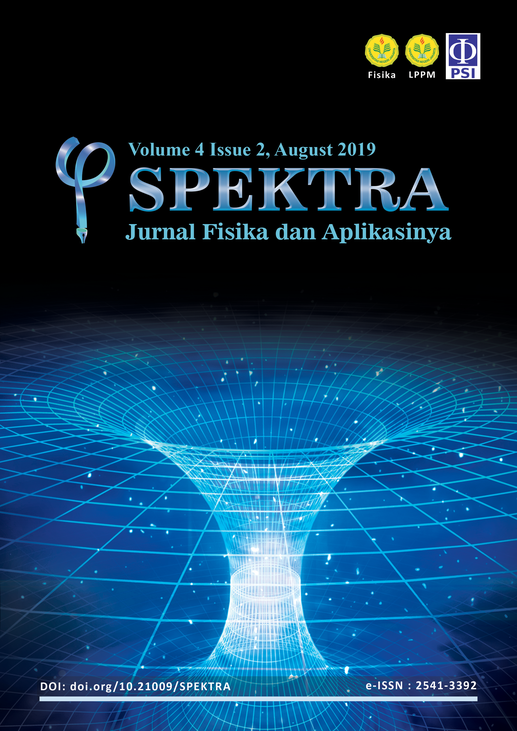THE SPRING VARIATION IN TWO DIMENSIONAL MODELING OF RED BLOOD CELL DEFORMABILITY BASED ON GRANULAR
DOI:
https://doi.org/10.21009/SPEKTRA.042.01Keywords:
deformability, granular, internal hydrostatic pressure, red blood cell, springAbstract
The red blood cell membrane has a complex structure and high deformability. Simulation of that complex red blood cell membrane can simpler use granular-based modeling. Red blood cell is modeled consisting of 50 granular particles connected by springs. An i-particle is connected with two of its first nearest particles which are i+1-particle and i-1-particle and with two of its second nearest particles which are i+2-particle and i-2-particle. Each particle has a spring force and forces from internal hydrostatic pressure. Spring force is a product of the spring constant and change of spring length of two particles. Meanwhile, forces of internal hydrostatic pressure is a product of particle diameter and the difference in the outside and inside pressure of red blood cell membrane. In this research, there is variation in spring length and spring constant that can model deformability of three shapes of red blood cell; those are biconcave, ellipse, and circle. This variation in spring length and spring constant for every cell shape in this modeling can also use for other initial cell shapes, which shows that initial cell shapes deform into shape according to variation used.
References
[2] Maciaszek, J. L. and G. Lykotrafitis, “Sickle Cell Trait Human Erythrocytes are Significantly Stiffer than Normal”, Journal of Biomechanics, vol. 44(4), pp. 657-661, 2011.
[3] I. Safeukui, P.A. Buffet, et al., “Quantitative Assessment of Sensing and Sequestration of Spherocytic Erythrocytes by the Human Spleen”, Blood, vol. 120, pp. 424-430, 2012.
[4] M. Muller, K. Katsov, et al., “Biological and Synthetic Membranes: What Can be Learned from a Coarse-Grained Description?”, Physics Rep., vol. 434(5-6), pp. 113-176, 2006.
[5] I. Yasifa and S. Viridi, “Pemodelan Dua Dimensi Deformabilitas Sel Darah Merah berbasis Granular”, Prosiding SNIPS ITB 2018.
[6] Fedosov, A. Dmitry, et al., “Coarse-Grained Red Blood Cell Model with Accurate Mechanical Properties, Rheology, and Dynamics”, Proc. Eng. in Medicine and Biology Soc., 2009 Annu. Int. Conf. IEEE, pp. 4266-4269, 2009.
[7] Pamplona, D.C, Goncalves, P. B., et al., “Finite Deformations of Cylindrical Membrane under Internal Pressure”, Int. J. Mechanical Sciences, vol. 48(6), pp. 683-696, 2005.
[8] Diez-Silva, M., et al., “Shape and Biomechanical Characteristics of Human Red Blood Cells in Health and Disease”, MRS Bull, vol. 35, pp. 382-388, 2010.
Downloads
Published
How to Cite
Issue
Section
License
SPEKTRA: Jurnal Fisika dan Aplikasinya allow the author(s) to hold the copyright without restrictions and allow the author(s) to retain publishing rights without restrictions. SPEKTRA: Jurnal Fisika dan Aplikasinya CC-BY or an equivalent license as the optimal license for the publication, distribution, use, and reuse of scholarly work. In developing strategy and setting priorities, SPEKTRA: Jurnal Fisika dan Aplikasinya recognize that free access is better than priced access, libre access is better than free access, and libre under CC-BY or the equivalent is better than libre under more restrictive open licenses. We should achieve what we can when we can. We should not delay achieving free in order to achieve libre, and we should not stop with free when we can achieve libre.
 SPEKTRA: Jurnal Fisika dan Aplikasinya is licensed under a Creative Commons Attribution 4.0 International License.
SPEKTRA: Jurnal Fisika dan Aplikasinya is licensed under a Creative Commons Attribution 4.0 International License.
You are free to:
Share - copy and redistribute the material in any medium or format
Adapt - remix, transform, and build upon the material for any purpose, even commercially.
The licensor cannot revoke these freedoms as long as you follow the license terms.

 E-ISSN 2541-3392
E-ISSN 2541-3392  Focus & Scope
Focus & Scope  Editorial Team
Editorial Team  Reviewer Team
Reviewer Team  Author Guidelines
Author Guidelines  Article Template
Article Template  Author Fee
Author Fee  Publication Ethics
Publication Ethics  Plagiarism Policy
Plagiarism Policy  Open Access Policy
Open Access Policy  Peer Review Process
Peer Review Process  Retraction & Correction
Retraction & Correction  Licensing & Copyright
Licensing & Copyright  Archiving & Repository
Archiving & Repository  Contact
Contact  Mendeley
Mendeley 

